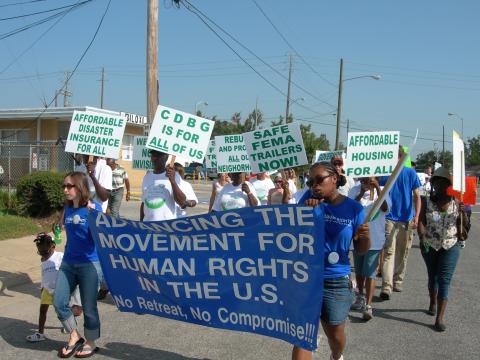About Us
 The US Human Rights Network is a national network of organizations and individuals working to strengthen a human rights movement and culture within the United States led by the people most directly impacted by human rights violations. We work to secure dignity and justice for all.
The US Human Rights Network is a national network of organizations and individuals working to strengthen a human rights movement and culture within the United States led by the people most directly impacted by human rights violations. We work to secure dignity and justice for all.
We work to realize human rights by:
- Engaging, connecting and mobilizing communities, Peoples, workers, and diverse sectors across issue areas, constituencies, and regions to uphold and defend human rights and hold government accountable;
- Building the capacity and leadership of grassroots groups and individuals to effectively apply the human rights framework in developing strategy and making long-term structural shifts to achieve justice;
- Raising the visibility of local human rights concerns and activism to shape the public discourse locally, nationally, and internationally; and
- Facilitating effective collective action to secure the structural change needed to fully realize human rights.
The US Human Rights Network is guided by these core principles:
- Human rights are universal, interdependent, indivisible, and inalienable.
- Human rights movements must be led by those most directly affected by human rights violations.
- Human rights advocacy and organizing should prioritize the struggles of the poor and most marginalized groups in society.
- Human rights movements must be inclusive and respect and reflect the diversity within communities.
- Human rights encompass civil, political, economic, social, cultural, environmental, sexual, and development rights for individuals, Peoples, and groups.
What We Do
USHRN serves as a facilitator and a catalyst to build and expand the base of the domestic human rights movement, supporting the growth of an active, multi-sector movement – one that utilizes the human rights frame to identify the root causes of violations and to call on government to address the realities on the ground.
Currently USHRN is made up of more than 300 member and partner organizations working on multiple human rights issues. USHRN remains an anchor of the domestic rights movement and supports a bold, broad-based people-centered human rights movement—one that is led by people most directly impacted by rights violations; comprised primarily of grassroots and community based groups and individuals working collectively and across issue areas; and highlights the human rights concerns of the least popular and most overlooked groups in our society including people living in or near poverty, people caught up in the system of mass incarceration, undocumented immigrants, poor single mothers, persons with disabilities, and indigenous peoples.
USHRN places priority on elevating and amplifying the voices of those who are marginalized and vulnerable, and whose voices are most often ignored.
How We Work
Member organizations are linked through various member structures. Member Initiated Action Teams, Working Groups, and Task Forces of USHRN allow members to collaborate within and across issue areas.
Member Initiated Action Teams (MIATs) provide opportunities for members to initiate their own action teams around human rights topics that interest them so that members are encouraged to learn from one another, collaborate, and take action. These member lead groups bring together and coordinate a diverse group of members who work directly with staff to plan, develop and implement key areas of work that are outlined in the strategic plan. MIATs are housed under the Membership Department.
Working Groups consists of teams of Network members working together on a single Campaign or issue area. Working Groups are traditionally organized around a specific campaign, such as Land and Housing or Water Rights, but can also coalesce around human rights issue areas. Working Groups are housed under the Campaigns Department.
International Mechanisms Task Forces are organized around specific International Mechanisms. For example, if the US government is up for review under the Convention Against Torture (CAT), a CAT Task Force is formed in order to track developments of the review and to help coordinate appropriate responses to the review. Task Forces can remain in existence for a short period of time or over a longer period, such as under the International Decade for People of African Descent. The overall coordination of Task Forces falls under the auspices of the International Mechanisms Coordinating Committee (IMCC). Task Forces are housed under the International Mechanisms Department.
On occasion, the Network also forms Committees for particular purposes, such as organizing the US Human Rights Network Biennial Convention.
Our Strategic Statement
In order to advance our mission and program, the US Human Rights Network has developed and approved a Strategic Statement for 2017-2020. The Statement defines our priorities and areas of focus, as well as a roadmap on how to achieve our mission.
Read the USHRN 2017-2020 Strategic Plan Here


